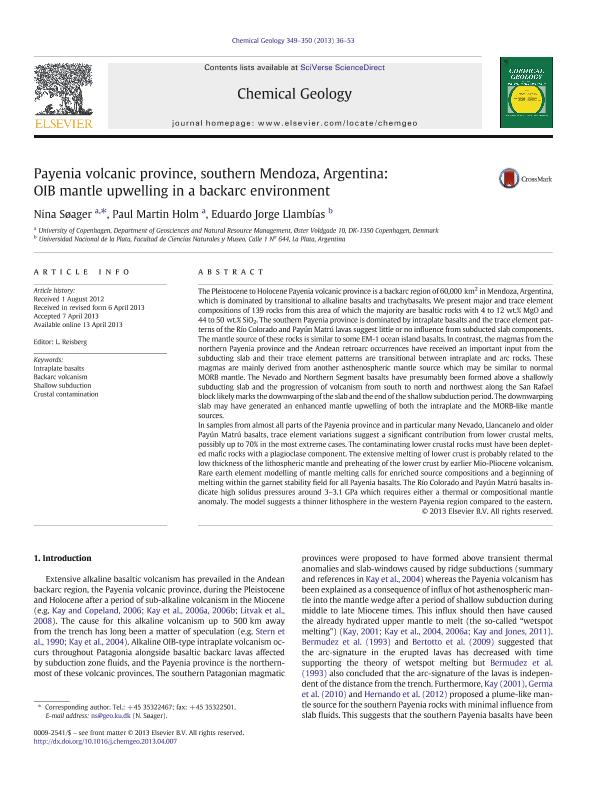Artículo
Payenia volcanic province, southern Mendoza, Argentina: OIB mantle upwelling in a backarc environment
Fecha de publicación:
06/2013
Editorial:
Elsevier Science
Revista:
Chemical Geology
ISSN:
0009-2541
Idioma:
Inglés
Tipo de recurso:
Artículo publicado
Clasificación temática:
Resumen
The Pleistocene to Holocene Payenia volcanic province is a backarc region of 60,000 km2 in Mendoza, Argentina, which is dominated by transitional to alkaline basalts and trachybasalts. We present major and trace element compositions of 139 rocks from this area of which the majority are basaltic rocks with 4 to 12 wt.% MgO and 44 to 50 wt.% SiO2. The southern Payenia province is dominated by intraplate basalts and the trace element patterns of the Río Colorado and Payún Matrú lavas suggest little or no influence from subducted slab components. The mantle source of these rocks is similar to some EM-1 ocean island basalts. In contrast, the magmas from the northern Payenia province and the Andean retroarc occurrences have received an important input from the subducting slab and their trace element patterns are transitional between intraplate and arc rocks. These magmas are mainly derived from another asthenospheric mantle source which may be similar to normal MORB mantle. The Nevado and Northern Segment basalts have presumably been formed above a shallowly subducting slab and the progression of volcanism from south to north and northwest along the San Rafael block likely marks the downwarping of the slab and the end of the shallow subduction period. The downwarping slab may have generated an enhanced mantle upwelling of both the intraplate and the MORB-like mantle sources. In samples from almost all parts of the Payenia province and in particular many Nevado, Llancanelo and older Payún Matrú basalts, trace element variations suggest a significant contribution from lower crustal melts, possibly up to 70% in the most extreme cases. The contaminating lower crustal rocks must have been depleted mafic rocks with a plagioclase component. The extensive melting of lower crust is probably related to the low thickness of the lithospheric mantle and preheating of the lower crust by earlier Mio-Pliocene volcanism. Rare earth element modelling of mantle melting calls for enriched source compositions and a beginning of melting within the garnet stability field for all Payenia basalts. The Río Colorado and Payún Matrú basalts indicate high solidus pressures around 3–3.1 GPa which requires either a thermal or compositional mantle anomaly. The model suggests a thinner lithosphere in the western Payenia region compared to the eastern.
Archivos asociados
Licencia
Identificadores
Colecciones
Articulos(CIG)
Articulos de CENTRO DE INVEST.GEOLOGICAS (I)
Articulos de CENTRO DE INVEST.GEOLOGICAS (I)
Citación
Soager, Nina; Holm, Paul Martin; Llambias, Eduardo Jorge; Payenia volcanic province, southern Mendoza, Argentina: OIB mantle upwelling in a backarc environment; Elsevier Science; Chemical Geology; 349-350; 6-2013; 36-53
Compartir
Altmétricas




